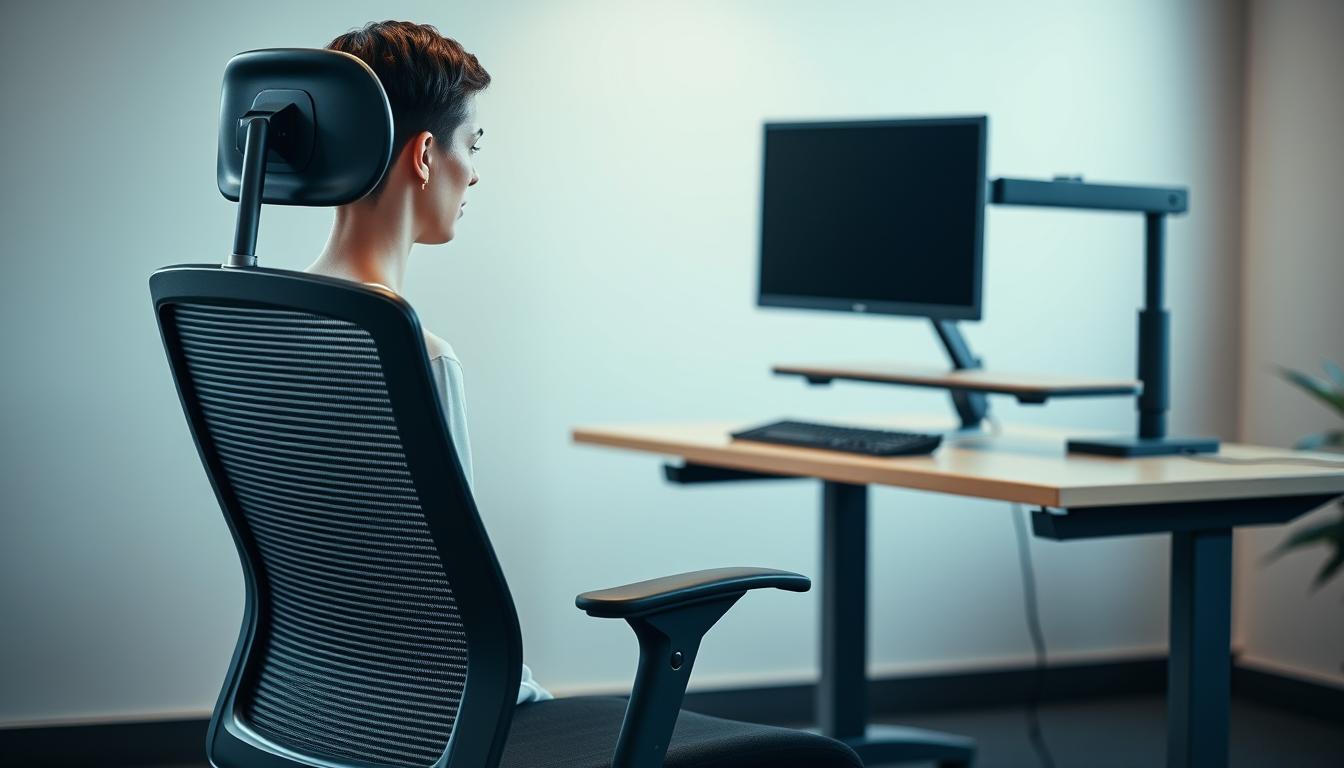In today’s world, keeping the right distance from your monitor is key for your eyes and neck. This guide will show you how to set up your screen to avoid discomfort and protect your health. Knowing the best distance from your computer screen helps you set up a comfortable workspace for long hours of use.
Dangers of Sitting Too Close to the Computer Screen
Sitting too close to a computer screen can be bad for your health. It causes problems like eye strain and neck pain. We’ll talk about these risks in more detail here.
Eye Strain and Fatigue
Looking at screens closely for too long can tire your eyes. You may not blink as much, leaving your eyes dry and irritated. Taking breaks often helps lessen these problems.
Headaches and Blurred Vision
Eye strain can also lead to headaches and blurry vision. The muscles in your eyes work overtime and get tired. Moving further away from the screen can make your vision clearer and reduce headaches.
Neck and Shoulder Tension
Sitting too close can also cause neck and shoulder pain. You might lean in to see better, which strains these areas. Keeping the right distance from your screen can help avoid this strain.
What Is the Ideal Distance from Computer Screen to Eyes?
Finding the right distance between your eyes and monitor matters a lot. It prevents discomfort and keeps your eyes healthy. You should keep the screen 20 to 40 inches away from you. This helps you see clearly and stay comfortable, especially if you use the computer a lot.
Recommended Viewing Distance
Different screen sizes mean you need to change how far you sit. If you have a 24-inch monitor, sitting about 24 inches away is good. For something bigger, like a 32-inch screen, you should sit 28 to 40 inches away. Changing your distance based on the monitor size helps avoid eye strain and keeps things clear.
Influence of Screen Size
The size of your screen affects how far away you should sit. With bigger screens, you need to sit further back to stay comfortable and see clearly. Moving your seat to match the screen size can make watching or working much better. It also fights off eye tiredness.
Potential Hazards and Solutions for Computer Workstations
Working at a computer without the right setup can cause problems. You might get eye strain, neck and shoulder pain, or other issues from bad ergonomics. But, you can greatly reduce these problems with the right ergonomic solutions.
Common Hazards
Badly set up workstations can lead to different issues. These problems include eye strain because the screen is too far or too bright. There’s neck and shoulder pain from not sitting right. Also, using the keyboard and mouse wrong can hurt your hands.
Ergonomic Solutions
It’s important to fix these workstation issues to stay comfortable and work well. To help with eye strain and improve ergonomics, here are a few tips:
- Make sure the top of your monitor is at eye level.
- Keep the screen right in front of you to help with your posture.
- Take short breaks often to lessen tiredness and help you focus better.
- Use screens that reduce glare to make looking at your monitor easier.
- Adjust your monitor’s angle to cut down on eye strain.
Monitor Setup for Optimal Viewing
It’s key to set up your monitor well to keep your eyes healthy and avoid neck pain. Having your monitor at the right height and angle makes a big difference when you’re in front of your screen for long hours. Making these adjustments can help you see better and sit correctly.
Correct Monitor Height
Your monitor should be positioned so the top is at or just below your eye level. This helps you keep a good posture easily, keeping your head straight. You should be able to look down at your screen at a slight angle of 10 to 20 degrees. This helps in lowering neck and shoulder tension.
Monitor Angle and Position
The angle of your monitor is important to reduce glare and keep viewing comfy. Putting the monitor right in front of you stops you from having to turn your neck. It should also be around an arm’s length away, which is the best distance for easy focus and less eye stress. The monitor should tilt a bit back to keep off glare from lights around you.
Understanding Viewing Angle and Distance
The relationship between viewing angle and the distance to your monitor is key for comfort. It helps prevent eye strain. Having the right angle is crucial in making your computer setup comfy. A good viewing angle keeps you relaxed, boosts work quality, and keeps you feeling good.
Importance of Viewing Angle
Choosing the right viewing angle lowers discomfort during long hours in front of the screen. Monitors should aim for a 15-degree tilt downwards. This helps line up your sight better, easing neck and eye stress. Ignoring this leads to bad posture. So, it’s vital to adjust your monitor correctly at the beginning.
Recommended Viewing Angle
The best viewing angle supports a comfy, natural body position. Consider both desk and monitor height to find the right setup. Following these tips makes you more comfortable. This lets you focus longer with less body strain.
Adjusting Monitor Distance for Comfort
Finding the right distance for your monitor is key to staying comfortable while using a computer. Things like how our bodies are built, how well we can see, and our daily routines matter a lot in finding that sweet spot. While keeping the monitor an arm’s length away is a good starting point, everyone is different. So, we’ll look into how each person’s unique needs can affect where their monitor should be for the best setup.
Individual Variability
People are different when it comes to setting up their monitor distance. Our eyesight, how long our necks are, and how we like our screens can vary. This means what works for one person might not for another. Some might need the monitor closer or further than an arm’s length. Trying out various distances is a good way to see what feels best. Paying attention to your body’s signals helps make long computer sessions more comfortable.
Using the ‘Arm’s Length’ Rule
The arm’s length rule is about sitting around 20 to 30 inches away from your monitor. This rule is a great place to begin, but don’t forget to think about your screen’s size and sharpness. Bigger screens might need you to sit a bit further back, while you can be closer to high-resolution ones. The key is to start with the arm’s length rule, then adjust until you find what’s most comfortable for you, reducing eye strain.
Monitor Distance Guide for Eye and Neck Health
It’s important to keep your monitor at the right distance. This helps your eyes and neck feel better for longer. Knowing the correct distance improves your work life, especially with different monitor sizes and resolutions.
Distance Recommendations for Different Monitor Sizes
The size of your monitor affects how far you should sit from it. Smaller screens are best viewed from about 20 inches away. But for larger monitors, you might need to be up to 40 inches away. This helps reduce eye and neck strain, and keeps your posture better when you’re using the computer a lot.
Effects of Screen Resolution on Distance
Screen resolution decides how close you can be to the monitor without the image getting blurry. With high-resolution screens, you can sit closer but still have a clear picture. If the resolution is lower, you need to sit a bit further back to stay comfortable. Following these tips will help keep your eyes and neck in good shape.
Optimizing Dual Screen Usage
Using two screens can really boost how much you get done if you set them up right. It’s important to place your monitors well so they help you work better. This way, you won’t hurt your eyes or neck and can stay focused and efficient.
Placement Strategies
Place your main monitor right in front of you. Put the second one at an angle so you won’t have to turn your neck much. Keep them 20 to 30 inches away. This makes sure you can see both without having to move your head too much.
Ergonomics of Dual Monitors
With two monitors, getting their heights right is key. Your main monitor should be at or just below where your eyes naturally look. This keeps your neck comfortable. Make sure the second monitor is at a similar height to keep your eyes level. Adjustable stands or arms are great for finding the perfect position for both screens.

Incorporating Breaks into Your Routine
Today, we spend a lot of time looking at screens. This is bad for our eyes. Taking regular breaks can help with this. The 20-20-20 rule is an easy way to keep your eyes happy. It means adding eye exercises and breaks into your day. This keeps your eyes feeling good and healthy.
The 20-20-20 Rule
The 20-20-20 rule helps stop your eyes from getting tired. It says that after 20 minutes of looking at a screen, you should look at something 20 feet away for 20 seconds. This helps your eye muscles relax and cuts down on eye fatigue. It’s a great habit, especially if you use the computer a lot.
Importance of Eye Exercises
Eye exercises go well with the 20-20-20 rule. Doing simple eye movements or focusing on different things gives your eyes a break. Regular eye exercises keep blood flowing and muscles flexible. This keeps your eyes comfortable and healthy.
The Role of Screen Settings in Eye Comfort
Setting your screen right is key for comfortable eyes when you’re on the computer a lot. You should adjust your display’s settings often. This helps avoid eye tiredness and makes looking at the screen better. Adjustments like brightness, contrast, and how big the font is are important. They should match what you like and the light around you.
Adjusting Brightness and Contrast
It’s important to adjust your screen’s brightness and contrast the right way. This reduces glare and makes it easier to see. Your screen should match the light in the room. If it’s bright around, you might need a brighter screen. But in darker places, a less bright screen helps your eyes relax. Changing these settings can help you use the computer longer without your eyes getting tired.
Font Size and Display Settings
Picking the right font size helps your eyes too. If the text is too small, you might squint, which is bad for your eyes. Choose a size that’s easy to read from where you sit. Apart from font size, changing the color temperature of your display can also help. Warmer colors are usually better for your eyes if you’re looking at the screen a lot. Adjusting these settings makes looking at your screen better for your eyes.
Choosing the Right Accessories for Ergonomics
It’s not just about the furniture when creating an ergonomic workspace. The right ergonomic accessories are key to comfort and productivity. By positioning monitors and devices right, you can cut down on body strain during long work hours.
Monitor Arms and Stands
Monitor arms and stands let you adjust your screens. You can change the height and angle to keep a good distance, reducing eye and neck strain. It’s important to have your screens at eye level with the right stands to maintain good posture.
Ergonomic Chairs and Desks
Ergonomic chairs and desks play a big part in a comfortable workspace. They’re made to support your natural posture, helping to prevent back pain and other issues. Choosing quality ergonomic accessories shows how key comfort is to being more efficient at work.
Conclusion
Following a monitor distance guide is very important for keeping your eyes and neck healthy. By using the right distance based on screen size and resolution, you can stay comfortable when using the computer for a long time. This helps reduce eye strain and also prevents neck and shoulder pain, supporting your overall health.
Adding ergonomic tools like adjustable chairs and well-placed monitors to your workstation is also key. Don’t forget to take regular breaks and do eye exercises. These actions are part of a well-rounded plan to keep you productive and comfortable.
In the end, mixing these habits improves work comfort and productivity. It helps create a healthy balance between using technology and taking care of your health.



